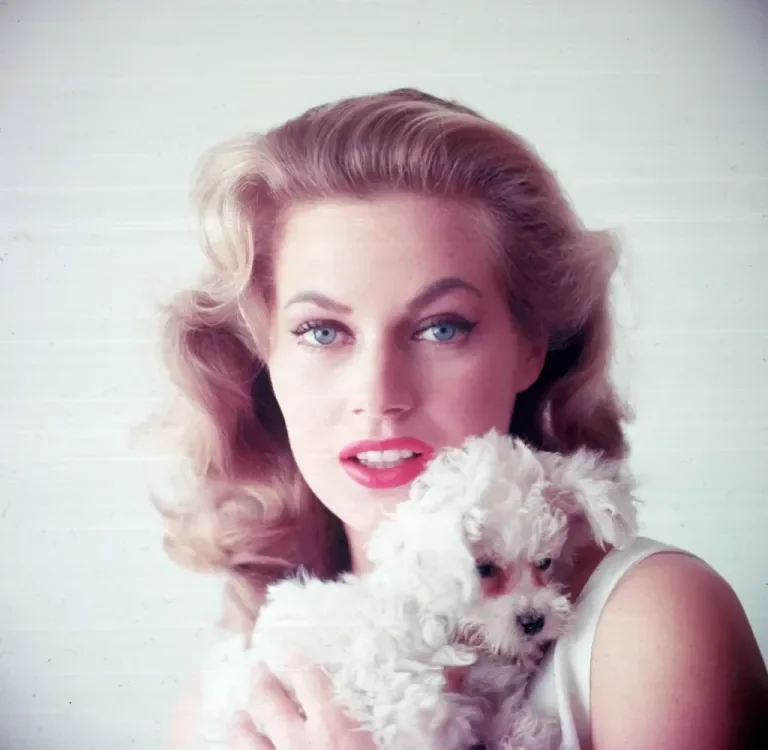Born on September 29, 1931, in Malmö, Sweden, Anita Ekberg grew up in a modest household as the sixth of eight children. Though her early years gave little hint of the international fame that awaited her, her striking beauty set her apart from an early age.

Her journey to stardom began in 1950 when she won the title of Miss Sweden. While she didn’t take home the Miss Universe crown, her participation in the pageant proved to be a turning point. The exposure brought her to Hollywood, where her captivating presence quickly caught the eye of industry insiders. This newfound recognition opened doors in modeling and acting, setting the stage for her entertainment career.
Breaking into Hollywood

Ekberg’s Hollywood debut came in the mid-1950s with supporting roles in films such as Blood Alley (1955), where she appeared alongside John Wayne and Lauren Bacall, and the comedy Artists and Models (1955), starring Dean Martin and Jerry Lewis. Her Nordic beauty and statuesque elegance earned her the nickname “The Iceberg,” reinforcing her image as a classic Hollywood bombshell. Popular media, including Playboy, frequently featured her, further cementing her status as a pop culture sensation.
La Dolce Vita and Global Stardom

However, it was her role in Federico Fellini’s La Dolce Vita (1960) that made her an international icon. Her portrayal of Sylvia, the enchanting yet elusive starlet, captured the essence of celebrity allure and mystery. The film’s most legendary moment—Ekberg wading through Rome’s Trevi Fountain in a flowing black gown—became one of the most enduring images in cinematic history.
Despite the worldwide recognition La Dolce Vita brought her, the role also led to typecasting, with many directors offering her parts that emphasized her glamorous persona. While this limited her opportunities for more diverse roles, Ekberg embraced the fame it afforded her, understanding the power of the image she had cultivated.
Life in Italy and Career Beyond Hollywood

Choosing to remain in Italy after her rise to stardom, Ekberg found greater creative freedom outside Hollywood’s constraints. She appeared in notable European films such as Boccaccio ’70 (1962), an anthology featuring works by Fellini and Vittorio De Sica, and 4 for Texas (1963), where she reunited with Dean Martin and Frank Sinatra. Though filmmakers often cast her in roles that leaned into her seductive image, she maintained a strong presence in European cinema, solidifying her legacy as a screen siren of her era.
“If I’d married an American and lived in Hollywood, I’d probably be on my third husband by now.”

Following a promising career in show industry, Rachel Ward appeared to vanish from the public eye.
Rather than pursuing celebrity, she concentrated on her 39-year marriage to Bryan Brown and their expanding family.
She is devoted to her two grandkids, who she now has.
About the same time that Rachel Ward met Bryan Brown, she was listed as one of the ten most beautiful women in the world. She was a rising star who had been nominated for a Golden Globe and appeared on the cover of UK Vogue.
Richard Chamberlain, her co-star in “The Thorn Birds,” was enamored with the stunning actress. Speaking about their time together on set, he remarked that because of his stunning co-star, all the love scenes were a pleasure to perform. She was in love with someone else, though, even as he was falling for her.
At one point, Chamberlain disclosed that Ward was falling in love with Brown at the time, indicating that she was a romantic, but regrettably not for him. Despite this, Chamberlain claimed that Ward’s enthusiasm was infectious, primarily due to the fact that they portrayed a couple in love.
He went so far as to say that it was easy to accept that Ward was in love with him and no one else. “I assumed I was the one! It was amazing. God, he used to think, ‘She’s really into me.
According to Ward, there was a strong attraction between her and Brown. “His pecs were nice.” It is, after all, quite chemical, don’t you think? She talked about what made her fall in love at first, saying, “It’s pretty basic.” In all honesty, there was no other way to explain her feelings—she simply liked him.
Brown, meanwhile, immediately concluded that Ward was “not a bad sort.” He was attracted to her right away, but it took him a while to express his interest in her. For Ward, however, this was no big thing because, according to Brown, it was a challenge she was eager to take on until he eventually changed.
It was obvious once Ward made up his mind about him: the 35-year-old ladies’ man, who was, to be honest, just a man averse to commitment, was done playing games. It was now time for him to be married, if not to the stunning Rachel Ward.
Despite coming from a shattered home, Brown never thought he would get married, but in nine months, he and Ward were married. Before Ward entered his life, he used to assure his mother that he would never get married.
Ward and Brown were married under different circumstances, despite the fact that many people decide to get married after discovering they have everything they could possibly need and want in a spouse. Brown was filming a project with Paul McCartney in London at the time. When Ward arrived, they got into a heated dispute.
Brown said, “I just thought we may as well get married if we’re going to argue like that.” In Oxfordshire, the home of Ward’s boyhood, they were married that year. After a while, they made Sydney their home, raising Rose, Matilda, and James, their three children.
Selecting an Alternative Course
Ward was the star of numerous songs prior to “The Thorn Birds.” Although her 1983 mini-TV series with Chamberlain was well-received, she eventually gave up acting due to scathing criticism of her performance. Speaking on her personal experience, she acknowledged:
“I took being slaughtered very seriously. After that, I never really regained my confidence.
Ward’s career was impacted by “The Thorn Birds,” but in the end, it helped her find the love of her life. As they waited for a take one day, Brown instructed Ward to raise her hand. When he saw three lines in her hand during his palm reading, he concluded that she would give birth to three children. They had no idea that they would end up having three children together.
Ward kept acting, but not very often. She made the decision to put her family first and relocated to her husband’s home country of Australia.
In response to a question concerning advice on preserving marriage, Brown says that one should “say yes to your wife all the time, and if anything goes wrong, say ‘it’s my fault.’” Men would be happier if they knew that.
Together, the charming couple had three children who all follow in their footsteps: The most well-known roles for their 1987-born daughter Matilda are in the television series “Lessons from the Grave,” “How God Works,” and “Let’s Talk About.” Their daughter Rosie is well-known for “Black Mirror,” “Inside No. 9,” and “Gangs of London,” while their only son Joe is well-known for “Let’s Talk About” and “Rake.”
Brown acted in the family-friendly film “Palm Beach,” directed by Ward, with his daughter Matilda. The family completed the project collectively.
When Matilda, Ward and Brown’s daughter, gave birth to Zan Neathway Gooding, her first boy, in 2019, the couple became grandparents for the first time. Brown remained by her daughter’s side, eager to eventually hold his grandson in his arms.
The actor did not sure how to react to being referred to as “grandfather,” even if he was a devoted grandfather, since it seemed to reveal his age. But whether he liked it or not, he had to admit that he would always be referred to as “grandpa.”
At first, Brown was concerned about becoming a grandfather because a lot of people were assuming he would adore it. When his grandchild arrived, he quickly became attached to the young boy and wanted to spend as much time as possible with him. He had wanted to work through that portion on his own.
Following the birth of her son, Matilda married Scott Gooding, formally becoming his adolescent son’s stepmother. They had originally planned to wed on Brown and Ward’s land in New South Wales, but they had to postpone their wedding due to the fear of a wildfire.
The family was forced to evacuate after the bushfires threatened to destroy their house. Although they would have preferred to wed at home like her parents did, Matilda decided to get married in Sydney to make sure everyone was safe.
Gooding’s kid was very involved in the wedding. With a broad smile on his face, he stood behind his father during the ceremony. According to the renowned chef, the wedding was “possibly the best moment” of his life, therefore it was the perfect unforgettable occasion.
Matilda is a happy mother of two now that he has had her younger siblings taken care of. Gooding posted a cute picture of his son strolling and pulling the pram of his younger siblings.
Similar to how Ward and Brown remain involved in their children’s life, they also make an effort to spend as much time as they can with their grandchildren. The devoted grandparents post glimpses of their grandparenting on Instagram, where they participate in a variety of activities.
Ward is seen gardening with her oldest grandson Zan in one cute video. In their herb garden, they can be seen sprinkling sugar cane mulch. Gooding boasts that his mother-in-law is “nurturing” her grandkids in the same manner that she strives to take care of the surroundings.
Zan spends time with their farm’s horses when he and his grandmother, whom he refers to as “mopie,” aren’t in the garden. They also spent a Christmas at the family farm, where the devoted grandma raised her first grandchild by exposing him to the animals at a young age to help him become accustomed to them.
Anouk, her second grandchild, arrived, and Ward made sure to spend equal time with him. One day, Gooding took pictures of Ward walking with her daughter Matilda and her second grandson, capturing the precious moment.
When their daughter Rosie became engaged to her fiance Andrew Cameron in 2020, their family grew even more. The start of a stunning partnership was marked by their Instagram engagement announcement.
After a span of two years, Rosie and Andrew joyfully relocated to a stunning new residence in New South Wales. Surrounded by a forest, waterfalls, and an abundance of avocado trees, the property has a modest house.
All of their neighbors stopped by to give the gorgeous couple a warm welcome when they arrived in the neighborhood. They declare they intend to stay awhile and claim to have everything they could possibly need in the town.
Cameron is an Australian regenerative farmer who shares Ward’s enthusiasm for the practice. He was a perfect fit for the rest of the Brown family, which made it simple for everyone to get along and share interests.
Ward and Brown have raised their family admirably throughout it all. Despite the fact that their children have grown, they maintain a close relationship and try to spend as much time as possible with their in-laws. The Browns, Goodings, and Camerons were a joyful family celebrating Christmas together in 2021.
Ward claims that at that point in her life, she most likely would have been married to a third husband if she had married an American and moved to Hollywood.
Ward and Brown are enjoying a successful marriage and their children are all grown up and independent. Ward acknowledges that she thinks there’s more to life than her marriage and her family life, even after 39 years of marriage and counting. Says she:
“While my family and marriage are very important to me, they are also not the end all be all.” I want to pursue a profession in acting because I adore it.
Ward has all the connections necessary to maintain her presence in Hollywood, even if she has spent the years living in Australia. As a matter of fact, she has been making the trip to Hollywood on demand for years.
Ward claims that even though it could have been more practical for her to live in America for her career, she most likely would have been married to her third husband by then if she had married an American and moved to Hollywood.
Rather, she is in a committed relationship with the passion of her life and has complete control over her house and family. When she’s not working on a project, the actress frequently shares with her kids what she does with pride.
One day, while painting her house over several days, her daughter Rosie captured her elevating a glass and the ladder she needed to do the job. Instagram users agreed with the happy daughter’s goal of showcasing what an amazing mother Ward was.
Ward shares more on her Instagram than only her abilities and priceless family moments—her sense of humor. She corrected misinformation regarding her activities during the COVID-19 pandemic.
She reported the following facts: (1) she hadn’t visited the US in more than five years; (2) she didn’t have a personal trainer; (3) she had spent the previous ten days at the mid-north coast; and (5) she lacked COVID-19. “Take a swing at another witch,” she concluded her amusing message.
Ward works on her farm while Brown is filming “Darby and Joan” on television. Together with other things, they are the owners of The Good Farm Shop, which offers ready-made, organic meals.



Leave a Reply